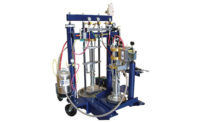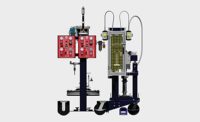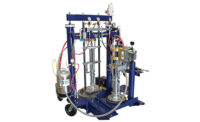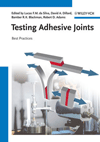Light-cure adhesives harden upon exposure to the appropriate wavelength and intensity of ultraviolet (UV) or visible light. Compared with other adhesive chemistries, light-cure adhesives offer a number of unique processing benefits. These materials fully cure within seconds, minimizing work-in-progress. Their ability to cure on command at room temperature makes them ideal for bonding parts that must be aligned prior to curing. Light-cure adhesives contain no solvents and have no pot life limitations. The equipment needed to cure these materials requires far less space and energy than conventional heat-cure ovens.
For an adhesive to react to UV or visible light, a chemical called a photoinitiator must be present in the formulation. Light emitted from a suitable source causes the photoinitiator to fragment into reactive species, initiating a rapid cure process. By definition, UV light is the region of the electromagnetic spectrum from 40 to 400 nanometers, while visible light is the region from 400 to approximately 800 nanometers.
When selecting the most appropriate curing equipment for a specific application, manufacturers must consider light irradiance and total light energy. Light irradiance measures the rate at which energy is delivered to the adhesive at a given moment of exposure. It is typically reported in watts per square centimeter for a given wavelength or region of the light-cure spectrum. Watts are joules per second, or energy over time.
Total energy is a measure of the total amount of light energy delivered to the adhesive over time. It is typically reported in joules per square centimeter for a given wavelength or region of the light spectrum. Exposing a sample of adhesive to low irradiance over a long time will deliver the same total energy as exposing the sample to high irradiance for a short time. However, the degree of cure and the performance characteristics of the adhesive may be dramati-cally different in the two situations.
The higher the irradiance or intensity of light that reaches an adhesive, the faster and deeper the adhesive will cure. Conversely, as light irradiance diminishes, cure rate slows and the ultimate depth of cure drops. Light irradiance also plays a key role in obtaining a tack-free surface with some adhesives, such as light-cure acrylics. These materials can sometimes produce a tacky surface, because oxygen consumes the reactive chemicals formed when the photoinitiator decomposes. With sufficient light irradiance, enough reactive chemicals are generated to harden the adhesive even after some have been consumed by oxygen at the adhesive surface.
Light-cure adhesives may be cured with low-, medium- and high-irradiance light sources, depending on the specific formulation and the requirements of the application. Generally, a low-irradiance product will cure when exposed to light irradiance of 25 to 30 milliwatts per square centimeter, while high-intensity irradiance adhesives require 80 to 100 milliwatts of energy per square centimeter and above. The specific manufacturing process, part design and end-use performance requirements of an application determine if the assembly is best suited for a low- or high-irradiance adhesive. In addition, variables such as the transmission prop-erties of the parts, color, depth of cure, surface cure and speed requirements also affect the design of a light-cure operation.
There are a wide variety of photoinitiators and light sources on the market. Light sources vary in terms of their output spectra—the regions of the light spectrum where they have their greatest output. Photoinitiators vary in their sensitivity to different regions of the light spectrum. For best performance, light source output should be selected with the absorbance characteristics of the adhesive in mind. As light output increases at the shorter wavelengths, such as in the UV C region, the speed of the surface cure will increase, while cure depth will diminish. Conversely, as light output increases at the longer wavelengths, toward the visible light end of the UV spectrum, cure depth will increase while surface cure speed will suffer.
Light-Cure Equipment
Light-cure equipment can be defined by two characteristics: the light source itself and the equipment’s part handling capabilities. With some equipment, the parts are kept immobile under the light source. Other equipment moves parts along under the light source during cure. All light sources can be incorporated in static or mobile equipment, depending on the application requirements.There are three broad categories of light sources: spot cure systems, flood systems and focused systems.
Spot cure systems are useful for focusing high levels of light energy into small areas. These systems consist of a lamp that is focused into a light guide. The light guide is a liquid-filled tube approximately 0.5 inch in diameter and several feet long, through which the light energy travels to reach the part.
Flood systems are more useful for irradiating large areas, but they produce lower irradiance. They consist of a bulb with a parabolic reflector that evenly distributes the light over a large work area, typically in the range of 8 by 8 inches.
Focused systems irradiate large areas with high intensity light by moving parts through a band of light under the bulb. These systems feature a higher output bulb held in an elliptical reflector that delivers a very high-intensity band of light focused under the bulb.
While spot cure systems typically use high-pressure mercury arc lightbulbs and flood cure systems often use metal halide bulbs, focused cure systems use a wide variety of lightbulbs. Two of the most popular types of bulbs are medium-pressure mercury arc lamps and electrodeless lamps. Understanding the differences between these two types of bulbs is important for selecting the correct light source.
Similar in configuration, medium-pressure arc lamps, metal halide bulbs and high-pressure mercury arc bulbs consist of a quartz tube with two electrodes at either end. All contain a small amount of mercury under vacuum. When the lamp is ignited, the mercury in the lamp is brought into a plasma state and gives off UV light. Over time, the output of electrode-based bulbs steadily decreases, increasing cure time and decreasing cure depth. To maintain acceptable performance, these bulbs must be replaced regularly, which adds to the cost of running these cure systems.
Electrodeless bulbs consist of only a quartz tube filled with chemicals that are excited to a plasma state via focused radio-frequency energy from a magnetron. Because there are no electrodes to degrade, the output of these bulbs remains more consistent over time and the bulbs typically last at least two to three times as long as an electrode-containing bulb. As a result, electrodeless curing systems are more cost-effective.
For curing large areas, medium-pressure mercury arc bulbs offer the significant benefit of being available in lengths up to 72 inches. Because the maximum length of electrodeless bulbs is just 10 inches, the cost of providing several electrodeless bulbs and their associated power supplies to irradiate a large area can mitigate the economic benefits offered by their longer life and more consistent output.
In many applications, spot cure or wand systems are preferred, because they focus very high levels of light irradiance in a small area. This enables them to rapidly cure the adhesive without exposing the entire assembly to UV light. This focusing capability minimizes the potential for heat degradation of the assembly, reduces space requirements, and lessens the need for ventilation and shielding of the light source.
As traditional spot cure systems age, longer and longer cure times are required to deliver the same total energy, decreasing the production rate and increasing production costs. In addition, peak irradiance will eventually drop sufficiently that depth of cure, surface cure and minimal cure speed requirements will be unachievable. At this point, the bulb, which typically makes up 5 percent to 10 percent of the cost of the entire wand system, will have to be replaced.
Historically, wand systems with higher light irradiance have had much steeper degradation curves than lower powered units. Higher powered wand systems give off larger amounts of infra-red (IR) energy, which can degrade the light guide and lead to a drop in light irradiance at its tip. Filters are commonly placed between the light source and the light guide to minimize IR transmission, but these filters can also degrade with time, leading to a drop in light output.
Because spot cure systems use electrode-based lamps, they have historically suffered from diminishing output over time. To address this problem, lower powered spot cure systems have been produced that show less degradation over time. However, they do not have the high output desired to minimize adhesive cure time. Complicated light-cure systems that vary light position over time to maintain consistent output have been used, but these designs add significant cost and complexity to the light-cure unit and do not address the costs of bulb replacement.
Recent developments in light-cure wand technology have delivered high-powered wand systems with dramatic improvements in long-term irradiance output consistency. These new systems improve the economics of light-cure processing and simplify the task of maintaining a consistent light-cure process. High-energy wand systems offer the high irradiance desired in a manufacturing environment, but maintain the consistent light irradiance critical to a robust manufacturing process.
Monitoring Light-Cure Processes
Light-cure processes are easy to control with regular monitoring and maintenance. The key to monitoring a light-cure process is a radiometer. This tool is used to measure the irradiance of a light source, and it is available in a variety of configurations to meet the needs of different cure processes. With spot cure systems, a cylindrical radiometer is typically used. The tip of the spot cure system is inserted into the end of the radiometer to measure wand irradiance. Radiometers must be calibrated on a regular basis, typically every 6 months, in accordance with the manufacturer’s instructions.For flood or focused systems, a disk-shaped radiometer can be placed on a conveyor and passed under the light source. If a static system is used, the radiometer can be placed in the same location as the part, to measure peak irradiance and total energy.
To maintain a light-cure system, establish a baseline when the system is working correctly by accurately measuring and recording the irradiance and total energy of the system. When measuring irradiance, the following information should be recorded so that the measurement can successfully be repeated in the future:
- The type of radiometer used and its calibration date. For the most consistent results, use the same radiometer for all future readings or at least the same model of radiometer, as different models can yield different results.
- The wavelength or UV region where the measurement is being taken. The output curve for any light source varies with wavelength.
- Exposure time. To achieve the same result if a conveyor is being used, record the belt speed and the distance from the light source to the belt.
- Type of lamp used. Different lamps have different output spectra. If lamp types are inadvertently changed, the cure characteristics of the system may change drastically, even if irradiance readings at a certain wavelength do not change.
- Position of the radiometer relative to the light source. The distance between the radiometer and the light source dramatically affects irradiance.
- Location of the radiometer with respect to the bulb, for focused systems. Output directly under the bulb will be much greater than the output just a few inches away from the bulb’s centerline. If possible, the radiometer should be placed in a position that closely mimics the position of the part under the light source.
Troubleshooting the Process
If the lamp being used is electrode-based, degradation of the bulb over time will be the most significant factor affecting light-cure performance. For these systems, determine the minimum irradiance that will produce satisfactory parts. Then, change the bulb once its output has degraded to the point that it cannot provide this level of irradiance.Prior to changing the bulb, inspect other aspects of the system that may be contributing to reduced output. For example, on focused systems, contaminants from the work environment can accumulate on the reflectors, making regular cleaning important. The filter glass between the metal halide light source and the curing area on flood systems should be cleaned of contaminants as well. On spot cure systems, outgassing products from the adhesives may accumulate in a thin layer on the tip of the wand. Regular cleaning of this tip can dramatically improve light output. Also, the spot cure light guide and any filters between the light source and the light guide can degrade.
If the light-cure equipment is producing output similar to the working baseline, but there are still problems, other factors must be considered. Check the shelf life and storage conditions of the adhesive or coating, and evaluate another lot from your supplier to see if the problems are lot-specific. Also be sure that the UV light transmission characteristics of the substrates have not changed. For example, different grades of polycarbonate can vary dramatically in their ability to transmit ultraviolet light, even though they may not differ in appearance.





